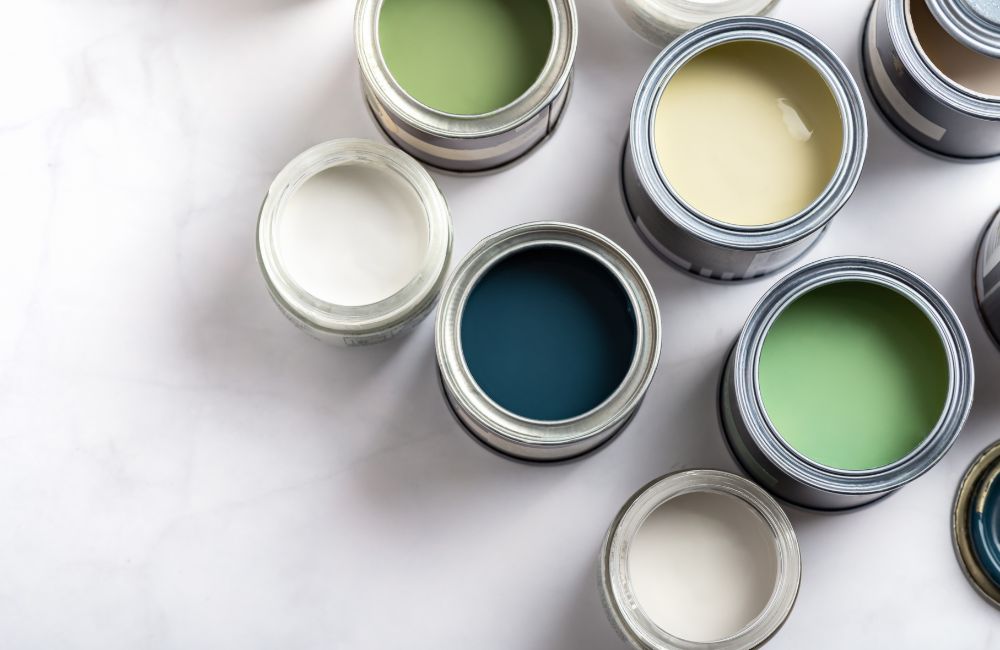Table of Contents
Key Takeaways
How do Colors Affect Mental Health?
What Paint Colors Can Help Reduce Depression and Anxiety?
How to Choose the Right Color for Your Home
Techniques and Products Used by House Painters
Frequently Asked Questions
| Key Takeaways ◉ The colors in our environment significantly affect our mental health, with house painters identifying top colors in 2024 that alleviate depression and anxiety. ◉ Serene blue and soft green are recommended for their ability to promote relaxation and balance. They are ideal for bedrooms and living areas. ◉ Warm beige and earthy taupe create cozy and stable environments, perfect for living rooms and offices. ◉ Gentle lavender and pale pink are excellent for reducing stress and promoting tranquility, making them suitable for bedrooms and meditation spaces. ◉ Muted yellow and soft coral are uplifting and energizing, beneficial for kitchens, dining areas, and creative spaces. ◉ Light gray and cool mint are chosen for their modern, calming, and refreshing properties, enhancing mental clarity and focus. |

The colors we surround ourselves with profoundly impact our mental health. As house painters understand, selecting the right colors can create an environment that promotes relaxation and reduces stress. In 2024, several paint colors emerged as favorites for their ability to alleviate symptoms of depression and anxiety.
How do Colors Affect Mental Health?
Colors profoundly affect our emotions and behaviors, influencing everything from calm and relaxation to energy and excitement. In 2024, popular paint colors recommended by house painters are selected not just for their aesthetic appeal but also for their psychological benefits. For instance, serene blue is associated with tranquility and can lower blood pressure and heart rate, making it an ideal choice for bedrooms and bathrooms where relaxation is essential. Soft green, another favorite, evokes balance and harmony, promoting a peaceful atmosphere perfect for living rooms and offices.
Understanding these effects can help you choose paint colors that enhance your living spaces, creating environments that support your emotional and psychological well-being. When choosing colors for your home, consider the specific mood you want to create in each room; soft, muted colors like pastels are generally soothing, while bright, saturated colors can be invigorating and uplifting. House painters with experience in color psychology can guide you in selecting the right hues to match your desired atmosphere, ensuring that your home is aesthetically pleasing and emotionally harmonious.
Modern Research on Color and Emotion
Recent studies in psychology and neuroscience have shown that colors can affect mood, cognitive performance, and even physical health, providing valuable insights for house painters who aim to create environments that support mental well-being.
Another significant area of research focuses on the effects of color on cognitive performance. Studies show that certain colors can enhance concentration and memory retention by increasing a person’s attention level and arousal.
For instance, green improves reading ability and comprehension, while blue enhances creative thinking. Moreover, color preferences can be influenced by cultural and personal factors, as what might be considered a calming color in one culture could evoke a different response in another. Personal experiences and associations also play a crucial role in how individuals perceive and react to different colors, and house painters often consider these factors, customizing their recommendations to suit their clients’ unique needs and backgrounds.
What Paint Colors Can Help Reduce Depression and Anxiety?
The year 2024 has brought a renewed focus on how the environment can impact mental health, with paint colors playing a significant role. House painters, leveraging their expertise in color psychology, have identified several paint colors that are particularly effective in reducing symptoms of depression and anxiety. These colors are chosen for their aesthetic appeal and calming and soothing properties, making them popular among homeowners looking to create a tranquil and supportive living environment.
- Serene Blue
Serene blue is renowned for its calming and tranquil effects. House painters often recommend this color for bedrooms and living areas where relaxation is paramount. This shade is perfect for creating a peaceful retreat in any home. Popular shades include sky blue and ocean blue, both of which evoke the serenity of nature. House painters find that these shades not only help reduce anxiety but also promote a sense of calm and relaxation, making them ideal for spaces where unwinding is essential.
- Soft Green
Soft green is another favorite among house painters for its soothing and restorative qualities. This color is reminiscent of nature, promoting a sense of balance and harmony. Popular shades for 2024 include mint green and sage green. House painters suggest using soft green in bedrooms, bathrooms, and any space where tranquility is desired. The natural association with foliage and the outdoors helps to create a calming environment that can reduce stress and anxiety.
- Warm Beige
Warm beige is comforting and inviting, making it a popular choice for living rooms and common areas. This neutral color creates a cozy atmosphere without overwhelming the senses. House painters recommend shades like sand beige and almond beige for a warm and welcoming home environment. The subtle warmth of these hues helps to foster feelings of comfort and security, which can be particularly beneficial in reducing feelings of depression and creating a homely, serene space.
- Gentle Lavender
Lavender is known for its relaxation properties and ability to reduce stress. House painters often use this color in bedrooms and meditation spaces. Popular shades for 2024 include soft lavender and lilac. Lavender creates a serene and restful environment, perfect for unwinding after a long day. House painters find that this color is especially effective in promoting a sense of calm and tranquility, which is crucial for reducing anxiety.
- Pale Pink
Pale pink has a soothing effect and is associated with feelings of love and tranquility. House painters recommend this color for nurseries and bedrooms. Popular shades include blush pink and rose pink. Pale pink adds a gentle and calming touch to any space, making it ideal for promoting mental well-being. House painters often use this color to create a soft, nurturing environment that can help alleviate stress and promote relaxation.
- Muted Yellow
Muted yellow is uplifting and cheerful without being overpowering. This color is perfect for kitchens and dining areas where a positive and inviting atmosphere is desired. House painters suggest shades like buttery yellow and lemon yellow. Muted yellow can brighten up a space and boost mood. House painters find that this color helps to create an energizing yet soothing environment, which can be particularly beneficial for combating symptoms of depression.
- Earthy Taupe
Earthy taupe provides a grounding and stable environment. This color is versatile and works well in various rooms, including living rooms and offices. House painters recommend shades like mushroom taupe and clay taupe. Earthy taupe brings a sense of calm and balance to any space. House painters often use this color to create a neutral, serene backdrop that helps to reduce anxiety and promote a sense of stability.
- Light Gray
Light gray is modern and serene, making it a popular choice for contemporary homes. This neutral color works well in living rooms, bedrooms, and offices. House painters suggest shades like dove gray and pearl gray. Light gray creates a sophisticated and calming environment. House painters find that this color helps to foster a sense of calm and clarity, which can be beneficial for reducing stress and enhancing mental well-being.
- Cool Mint
Cool mint is fresh and invigorating, perfect for bathrooms and kitchens. This color promotes clarity and rejuvenation. House painters recommend shades like mint green and ice blue. Cool mint can create a refreshing and calming space in any home. House painters often use this color to evoke a sense of cleanliness and renewal, which can help to reduce anxiety and promote a clear, focused mind.
- Soft Coral
Soft coral is uplifting and energizing, making it ideal for creative spaces and children’s rooms. This color adds a vibrant touch without being too intense. House painters suggest shades like peach coral and blush coral. Soft coral brings a sense of warmth and positivity to any room. House painters find that this color helps to create an energetic yet calming environment, which can be particularly beneficial for reducing symptoms of depression and promoting a positive outlook.

How to Choose the Right Color for Your Home
Selecting the right color for your home involves a blend of aesthetic preferences and practical considerations. The choice of color can profoundly impact the atmosphere of a room and the overall mental well-being of its occupants. Here’s a comprehensive guide to making informed color choices with the help of professional house painters:
- Understand the Specific Needs of Each Room
Different rooms in your home serve various functions, and the paint colors should align with these purposes. For instance, bedrooms and living areas often benefit from soothing colors that promote relaxation, while kitchens and workspaces might be better suited to more vibrant, energizing hues. House painters can help you identify the primary activities in each room and recommend colors that enhance those functions.
- Consider Natural Light
Natural light has a significant effect on how colors appear in a room. A color that looks perfect in a showroom might look entirely different under the lighting conditions of your home. South-facing rooms typically receive warm, direct sunlight, making colors appear warmer and more vibrant. In contrast, north-facing rooms get cooler, indirect light, which can make colors appear muted or bluish. House painters understand these nuances and can suggest colors that will look their best under the specific lighting conditions of your rooms.
- Determine Room Size and Color Perception
The size of a room can also influence your color choices. Lighter colors can make a small room feel larger and more open, while darker colors can create a cozy, intimate atmosphere in larger spaces. Professional house painters can provide insights into how different shades and tones can affect the perception of space, helping you create the desired ambiance in each room.
While aesthetics are important, the psychological impact of color should not be overlooked. House painters with experience in color psychology can guide you in selecting hues that not only look beautiful but also promote mental well-being. For example, they might recommend serene blues and greens for relaxation areas or uplifting yellows and soft corals for spaces where you want to boost mood and energy levels.
- Identify Personal Preferences and Style
Ultimately, your personal preferences and style should be reflected in your color choices. House painters can help you find colors that match your taste while also considering the practical and psychological aspects of color selection. They can provide color samples and even create test patches on your walls so you can see how different shades look in your space before making a final decision.

Techniques and Products Used by House Painters
Low-VOC Paints
Volatile Organic Compounds (VOCs) are chemicals found in many paints that can release harmful gases into the air, affecting indoor air quality and health. In response to growing health and environmental concerns, house painters are increasingly using low-VOC or zero-VOC paints. These eco-friendly options provide the same high-quality finish without the toxic fumes, making them a safer choice for homes, especially those with children, pets, or individuals with respiratory issues.
Textured Finishes
Textured finishes add depth and character to walls, creating a unique aesthetic that goes beyond traditional flat or satin finishes. Techniques such as sponging, rag rolling, and stippling can produce stunning effects that enhance the visual interest of a room. House painters skilled in these techniques can customize textures to suit your style, whether you prefer a subtle, understated look or a bold, dramatic statement.
Advanced Application Methods
Technology and innovation have introduced new tools and methods for paint application. Airless sprayers, for instance, allow for a smooth, even coat of paint with minimal overspray, resulting in a professional finish in less time. House painters are also using precision tape and stencils to create crisp lines and intricate designs, adding a level of detail that enhances the overall aesthetic of a room.
Sustainable and Eco-Friendly Practices
Sustainability is a key concern in modern painting practices. House painters are adopting eco-friendly practices, such as using paints made from natural ingredients and sourcing materials from sustainable suppliers. These practices not only reduce the environmental impact but also ensure that your home remains a healthy place to live.
Color Consultation and Digital Tools
Advancements in digital technology have revolutionized the way house painters approach color consultation. Tools like digital color matching and visualization software allow you to see how different colors will look in your space before any paint is applied. House painters can use these tools to create digital renderings of your rooms with various color schemes, helping you make more informed decisions.
Durability and Maintenance
Modern paints are designed to be more durable and easier to maintain than ever before. Stain-resistant, washable paints are ideal for high-traffic areas and homes with young children or pets. House painters can recommend products that will stand up to wear and tear, ensuring that your walls remain beautiful and easy to clean for years to come.

Frequently Asked Questions
How often should you repaint to maintain mental health benefits?
To maintain the aesthetic appeal and the mental health benefits of your living space, it is recommended to repaint every 3-5 years. Over time, paint can fade, chip, or become dingy, which can negatively impact the mood-enhancing effects of your chosen colors. Regular repainting helps to refresh your environment, ensuring that the calming and uplifting qualities of colors like serene blue or soft green continue to provide a supportive and harmonious atmosphere. House painters can assess the condition of your paint and advise on the optimal repainting schedule to keep your home looking vibrant and feeling tranquil.
What should I discuss with my house painter before starting a project?
Before starting a painting project, it’s important to have a thorough discussion with your house painter about your goals, color preferences, and any specific mental health benefits you are seeking. Share your vision for each room, including how you want to feel in the space and any psychological effects you hope to achieve with certain colors. House painters can provide expert advice on selecting shades that promote relaxation, reduce anxiety, or boost mood, based on their knowledge of color psychology. Additionally, discussing practical considerations such as budget, timeline, and paint types (e.g., low-VOC options) ensures that your project aligns with both your aesthetic and health-related goals.
Can house painters provide samples or test patches?
Yes, many house painters in Westport, CT, offer samples or test patches to help you visualize how different colors will look in your space before making a final decision. This service is particularly beneficial when trying to achieve specific mental health outcomes, as it allows you to experience the effects of colors like pale pink or muted yellow in the actual lighting and context of your room. By applying small test patches on your walls, house painters enable you to compare different shades side by side, ensuring that you choose the color that best meets your aesthetic preferences and emotional needs. This step also helps to avoid any surprises and ensures satisfaction with the final result.

Transform Your Home and Mind — Hire Custom Colonial Painting Today!
Choosing Custom Colonial Painting means entrusting your home in Westport, CT, to experts who understand the profound impact of color on mental well-being. Our team specializes in selecting the perfect shades from the 10 popular paint colors in 2024 that are proven to reduce depression and anxiety, according to house painters.
We combine this expertise with high-quality workmanship and a commitment to exceptional customer satisfaction. Whether you’re looking to create a serene retreat with serene blue or a rejuvenating space with cool mint, our professional painting services will transform your home into a sanctuary that enhances both aesthetics and mental health.
Trust Custom Colonial Painting to bring a harmonious and calming environment to your living space, ensuring a beautiful, stress-free home in Westport, CT, tailored to your unique needs.









